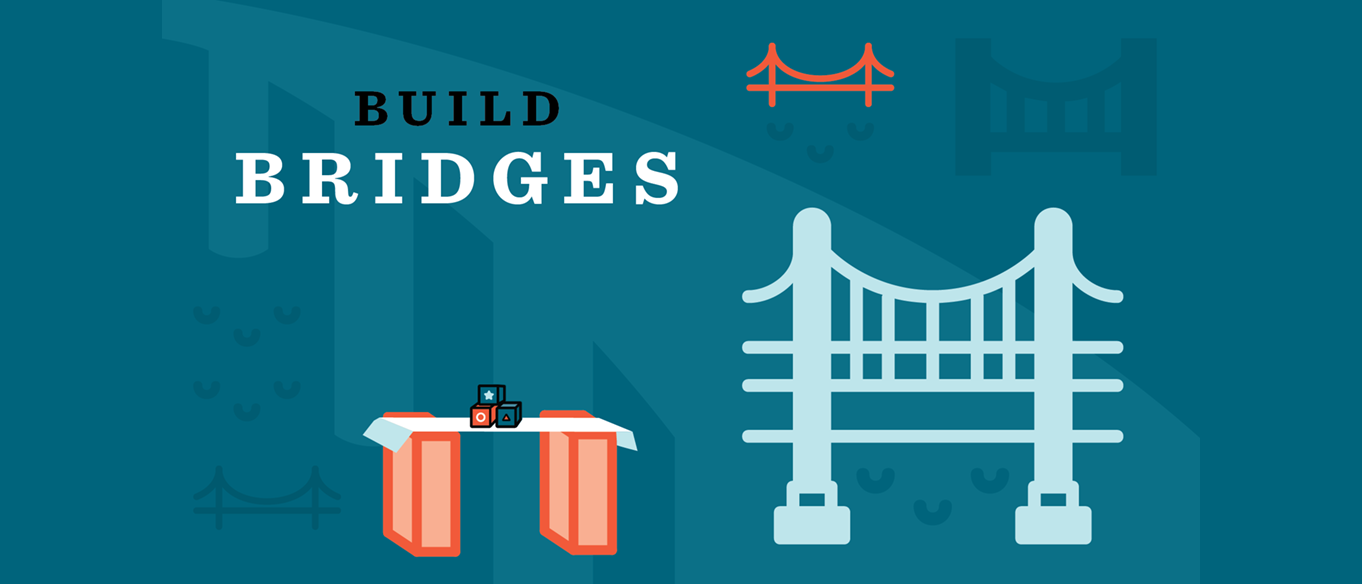
How much weight can a piece of paper hold? Test how folding your paper into different structures can make a stronger bridge.
Age: 6+
Time: 20 minutes
Topics: paper, load, weight, structure, design challenge
What you need:
- Two blocks or books to support the sides of the bridge
- 2-3 pieces of paper (cut in half, lengthwise, to form long strips)
- Weighted objects such as blocks, coins, washers, erasers, or plastic animals
What to do:
1. First, place your two blocks or books about 8 inches apart. You will be building a bridge that crosses this distance.
2. Start your design process by thinking and talking about bridges you have seen. For example:
- Where are some bridges in your community? Why have people built bridges in those locations?
- What kind of traffic does each bridge carry? Which bridge needs to support the most weight?
- Think about what each bridge looks like. Try drawing what you remember about their designs.
3. Do some research by looking at photos of real-world bridges for inspiration.
- Try searching for simple footbridges. What shapes do you see?
- Compare with more complicated road bridges. Some famous examples in the United States include the Lake Pontchartrain Causeway in Louisiana, the New River Gorge Bridge in West Virginia, the Commodore Barry Bridge connecting Pennsylvania and New Jersey, and the Golden Gate Bridge in California. Do you see any of the same shapes you observed in the simpler bridges? Do you notice any differences?
4. Now make a plan for your bridge. Start by observing what happens when you place a strip of paper across your blocks. How can you fold the paper to make a bridge that can support its own weight? Sketch your bridge, showing the shapes you might see on different sides of the bridge.
5. Put your design to the test! Fold up your paper according to your plan and place it over the blocks. Does it support its own weight, or does it sag in the middle?
6. Start adding weight to your bridge.
- How much weight can it hold before it collapses? Write down the number of objects next to your sketch.
- How could you redesign your bridge to hold more weight?
7. Change your design based on your observations. Fold a new strip of paper in a different way and then test it again! Think about things like:
- What shapes do you form as you fold the paper? Sketch each new design as you build, and record the weight it can support.
- Is there a difference between putting all the weight in the center of the bridge or spreading it out across the bridge?
- How does the width of your bridge change? What might that mean for traffic in the real world?
What’s happening?
A bridge has to support its own weight, known as its dead load. When it’s just a flat strip, your paper isn’t very strong, and it sags between the two blocks. Your first challenge was to fold the paper to hold its dead load and support itself across the blocks. A bridge also has to support the weight of anything placed on it, known as the live load. In the real world, the live load might be people, cars and trucks, or trains. You tested different ways of folding the paper to support heavier live loads of your different objects. You might also have tested spreading out your objects over your bridge; this reduces the load at any one point on the bridge. Engineers have to make sure a bridge is strong enough to handle even the heaviest live load—not to mention unpredictable factors like wind and weather!
We find many different types of bridges around the world, but four common designs are 1) beam bridges, 2) arch bridges, 3) cantilever bridges, and 4) suspension bridges. Engineers decide which type of bridge to build based on many different factors, such as location, length, load, and cost. For example, suspension bridges—where the bridge hangs from tall towers, like the Golden Gate Bridge—can stretch over long distances but are expensive to build. Beam bridges—made of horizontal beams stretching across, like the Lake Pontchartrain Causeway—are much easier to build but are supported by short vertical columns that must be placed close together. Triangular structures are often used in bridges because they can spread out the weight of the load while still holding their shape. What designs do you see in the bridges in your community?
When designing new bridges, engineers use the engineering design process:
- Research – Find out what other people have already made or discovered related to the item.
- Gather requirements – List all the things the new item needs to have, be, or do in order to work correctly.
- Brainstorm and plan – think of lots of different design ideas and then choose the best one.
- Build and test – make a first version of the item and test it.
- Redesign and retest – keep changing, testing, and improving the design until it meets all the requirements as well as it possibly can.

